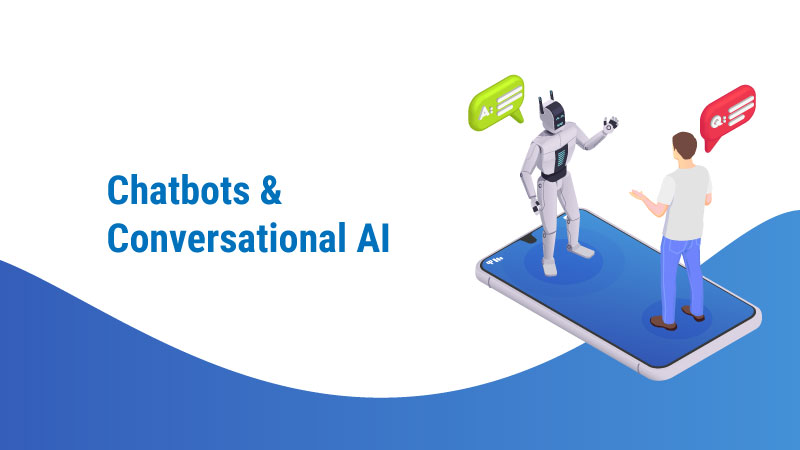Are you planning to use Conversational AI for your enterprise? You are not alone. Many enterprises are exploring the choice of moving beyond simple customer support to agile and responsive operations designed to provide a superior customer experience. To get the most out of your investment, it is crucial to understand what your enterprise can expect to achieve by implementing Conversational AI. This technology represents a significant leap forward from the inflexible replies of traditional chatbots to adaptive, intelligent, and responsive actions driven by true AI-based systems.
As per a report by Juniper Research, chatbots will provide a cost savings of $11 billion per year by 2023, nearly 190% more than the current annual savings of $6 billion. These savings will result from the more intelligent application of Conversational AI technologies, as legacy IVR systems and simple chatbots alone will not be able to deliver these cost-saving results. So, let us dive in to explore the key aspects of Conversational AI and why it might be the game-changer your business needs.
What Exactly is Conversational AI?

Conversational AI encompasses a set of advanced technologies, such as intelligent voice assistants and chatbots, designed to facilitate communication between users and computers. This is achieved by recognizing and processing multiple languages, understanding text and speech, and translating the meaning into the user’s native language. Conversational AI involves several cutting-edge technologies, including:
- Machine Learning (ML): Enables systems to learn from data and improve over time without explicit programming.
- Natural Language Processing (NLP): Processes and understands human language.
- Natural Language Understanding (NLU): Deciphers the meaning of the user’s input.
- Natural Language Generation (NLG): Produces responses in a natural and coherent manner.
- Predictive Analysis: Forecasts future trends based on historical data.
- Deep Learning (DL): Utilizes neural networks to mimic human decision-making processes.
Unlike traditional NLP techniques, modern AI applications use Deep Learning techniques to process user queries, understand them, and respond naturally. These advanced neural networks, often pre-trained on vast datasets, can extract the meaning of user utterances, understand context, and even gauge sentiment. Moreover, with the advent of Reinforcement Learning (RL), future AI platforms will be capable of improving themselves through continuous user interactions, much like humans do with experience.
How Does It Differ from Existing Chatbots?

Traditional chatbots are limited by their reliance on predefined responses that are configured per specific use cases. They operate based on hard-coded rule-based algorithms, which often lead to rigid and unsatisfactory interactions. If a chatbot cannot provide the desired information, it typically either redirects the user to the homepage or escalates the conversation to a live agent.
Conversational AI, on the other hand, offers a more sophisticated and flexible alternative. It can engage in dynamic conversations using both voice and text, responding to user queries in a more human-like manner. Additionally, Conversational AI can adapt to subtle changes in conversation, providing a personalized experience that goes beyond the capabilities of traditional chatbots.
Some of the major differences include:
- Limited Training Required: Modern Conversational AI systems require less data for training compared to traditional methods, thanks to advanced NLP engines that consider contextual aspects.
- Natural Language Generation: Unlike traditional chatbots that rely on predefined templates, Conversational AI systems use sophisticated Transformer-based decoder models to generate meaningful responses.
- Breakthrough Voice Technology: Modern Conversational AI applications are equipped with ultra-realistic voice capabilities, incorporating human-like pauses, nuances, and emotional tone modulations.
- Customer-Centric Approach: Modern Conversational AI allows customers to express themselves freely, offering a more natural and satisfying interaction experience.
Why Conversational AI Matters for Businesses Today
The resurgence of Conversational AI in the enterprise world marks a significant shift in how businesses approach customer interaction and service automation. Traditional chatbots often fell short of delivering the efficiency organizations sought through automation due to technological limitations. However, modern Conversational AI systems are now fulfilling that long-awaited promise with their true AI-based flexible design. Industries such as healthcare, telecommunications, banking, insurance, and IT are increasingly adopting conversational automation worldwide, demonstrating the advanced benefits of this technology.
Here’s why Conversational AI matters for businesses today:
- Better Customer Experience: Conversational AI delivers a superior customer experience, often surpassing live human agents by providing accurate and timely responses. This enhances customer satisfaction and builds trust.
- Reduced Waiting Times: With the ability to handle large customer loads efficiently, Conversational AI significantly reduces average customer resolution times, minimizing wait times and improving overall service speed.
- Improved Customer Service: By automating routine and repetitive queries, Conversational AI allows live agents to focus on more complex issues, leading to higher-value service and increased query resolution rates.
Why Conversational AI is a Smart Investment for Your Enterprise
Conversational AI is not only a cost-effective system but also a smart investment for enterprises looking to scale their operations, enhance customer engagement, and reduce operational costs. Here’s how Conversational AI benefits your business:
- Reduced Costs: By automating customer service, businesses can reduce operational costs by up to 30%. This includes savings on staffing and training costs, as Conversational AI provides 24/7 support.
- Higher Sales and Customer Engagement: Real-time interactions and quicker resolutions lead to higher customer satisfaction, driving additional sales and fostering customer loyalty. Conversational AI also facilitates cross-selling opportunities by introducing customers to new products or services.
- Scalability: Cloud-based Conversational AI systems allow for rapid scaling without the need to hire additional staff. This is particularly beneficial for businesses expanding into international markets.
- Modern User Interface: Unlike traditional chatbots, modern Conversational AI systems offer user-friendly interfaces that support both text and voice interactions. Omni-channel engagement through platforms like Web-based Text, WhatsApp, Facebook Messenger, and Voice telephony is now feasible, providing a seamless customer experience.
Some Technical and Operational Challenges

- Data Privacy and Security: One of the foremost challenges in implementing Conversational AI in data chat is ensuring the privacy and security of sensitive information. As AI systems handle large volumes of data, the risk of data breaches and unauthorized access increases. Protecting this data, especially in industries with stringent regulatory requirements, such as finance and healthcare, is paramount. Organizations must invest in robust encryption methods and stringent access controls to mitigate these risks.
- Integration Complexity: Integrating Conversational AI with existing systems can be a daunting task. Legacy systems may not be designed to work seamlessly with modern AI technologies, leading to compatibility issues. This challenge is exacerbated by the need to ensure that the AI system can access and interpret data from multiple sources. Overcoming these integration challenges often requires significant customization and technical expertise, making the adoption process more complex and time-consuming.
- Natural Language Processing (NLP) Limitations: Although Natural Language Processing (NLP) has advanced significantly in recent years, it still faces limitations, particularly when dealing with complex or ambiguous queries. Ensuring that the AI accurately understands and responds to user queries is critical to the success of data chat applications. Developing sophisticated NLP models that can handle the nuances of human language requires substantial resources and ongoing refinement.
- Maintaining AI Accuracy: As data evolves over time, so too must the AI models that process it. Maintaining the accuracy of AI responses requires continuous monitoring and updating of the models to reflect the latest data trends and user behaviors. Without proper maintenance, the effectiveness of the AI system can degrade, leading to user frustration and decreased trust in the technology.
- User Acceptance: Gaining user trust and acceptance of Conversational AI-based systems is another significant challenge. Users may be skeptical about relying on AI for tasks that have traditionally been handled by humans. This skepticism can be rooted in concerns over the accuracy of AI responses, data security, and the perceived loss of personal touch in interactions. Overcoming this barrier requires clear communication of the benefits of AI and a user-centric approach to design and implementation.
- Training and Onboarding: Successfully deploying Conversational AI in data chat requires that employees be adequately trained to use and manage the technology. This training includes not only understanding how to interact with the AI system but also how to troubleshoot issues and interpret AI-generated insights. The learning curve can be steep, and organizations must be prepared to invest in comprehensive training programs to ensure a smooth transition.
- Cost of Implementation: The cost of implementing Conversational AI can be prohibitive for some organizations. Initial expenses include purchasing or developing the AI system, customizing it to meet specific needs, and integrating it with existing systems. Additionally, ongoing costs such as maintenance, updates, and training must be factored in. However, these costs can be offset by the long-term benefits of increased efficiency and improved customer experience.
- Change Management: Transitioning from traditional systems to AI-powered tools often faces resistance from employees who are accustomed to established workflows. Change management strategies are essential to address this resistance and ensure that the adoption process is as smooth as possible. This includes clear communication, involving key stakeholders in the decision-making process, and providing ongoing support to ease the transition.
The Opportunities Arise
 Advanced Analytics: Despite the challenges, the opportunities presented by Conversational AI in data chat are immense. One of the most significant advantages is the ability to perform advanced analytics on large datasets. AI can quickly analyze and interpret data, providing real-time insights that can inform decision-making and drive business strategy. This capability allows organizations to respond more quickly to market trends and customer needs.
Advanced Analytics: Despite the challenges, the opportunities presented by Conversational AI in data chat are immense. One of the most significant advantages is the ability to perform advanced analytics on large datasets. AI can quickly analyze and interpret data, providing real-time insights that can inform decision-making and drive business strategy. This capability allows organizations to respond more quickly to market trends and customer needs.
- Scalability: Conversational AI systems are highly scalable, capable of handling a large volume of interactions simultaneously. This scalability is particularly beneficial for organizations that experience fluctuating demand or need to support users across multiple time zones. AI systems can operate 24/7, providing consistent support without the need for additional human resources.
- Automation of Repetitive Tasks: Conversational AI can automate a wide range of repetitive tasks, freeing up human employees to focus on more strategic activities. For example, AI can handle routine data queries, generate reports, and even manage basic customer service interactions. This automation not only increases efficiency but also reduces the risk of human error, leading to more accurate and reliable outcomes.
- Personalization: AI systems can provide highly personalized responses based on user preferences and past interactions. This level of personalization enhances the user experience by delivering relevant and timely information, making interactions more meaningful and satisfying. As AI continues to learn from each interaction, its ability to deliver personalized content improves, fostering stronger customer relationships and loyalty.
- Continuous Learning: Conversational AI systems are designed to learn and improve over time. Each interaction provides new data that the AI can use to refine its models and improve accuracy. This continuous learning process ensures that the AI remains relevant and effective, even as user behaviors and data trends evolve. Organizations can leverage this adaptability to stay ahead of the competition and continuously improve their service offerings.
- Enhanced User Experience: Ultimately, the goal of adopting Conversational AI in data chat is to enhance the user experience. By providing faster, more intuitive access to data and insights, AI can empower users to make informed decisions quickly and confidently. This improved user experience can lead to increased customer satisfaction, higher engagement rates, and a stronger competitive position in the market.
Conclusion: Is Conversational AI Worth the Investment for Businesses?
Adopting Conversational AI in data chat presents both significant challenges and exciting opportunities for organizations. While the technical and operational hurdles are considerable, the potential benefits in terms of advanced analytics, scalability, automation, personalization, and continuous learning make it a compelling investment. By carefully navigating the challenges and strategically leveraging the opportunities, organizations can harness the power of Conversational AI to drive growth, enhance customer experiences, and stay competitive in an increasingly data-driven world.
The question of whether Conversational AI is worth the investment for businesses is increasingly relevant as more organizations explore the potential of this technology. The answer, in short, is yes—if implemented strategically and aligned with business goals. Conversational AI offers a powerful way to enhance customer interactions, streamline operations, and provide actionable insights. However, the value of the investment depends on the organization’s ability to effectively overcome the challenges associated with AI adoption and fully leverage the opportunities it presents.
By investing in Conversational AI, businesses can improve efficiency, offer personalized customer experiences, and gain a competitive edge in a data-driven marketplace. While the initial costs and technical complexities may be significant, the long-term benefits, including scalability, automation, and continuous learning, can far outweigh these challenges. For companies willing to invest in the right resources and strategies, Conversational AI is not just worth the investment—it is a critical tool for future success.








